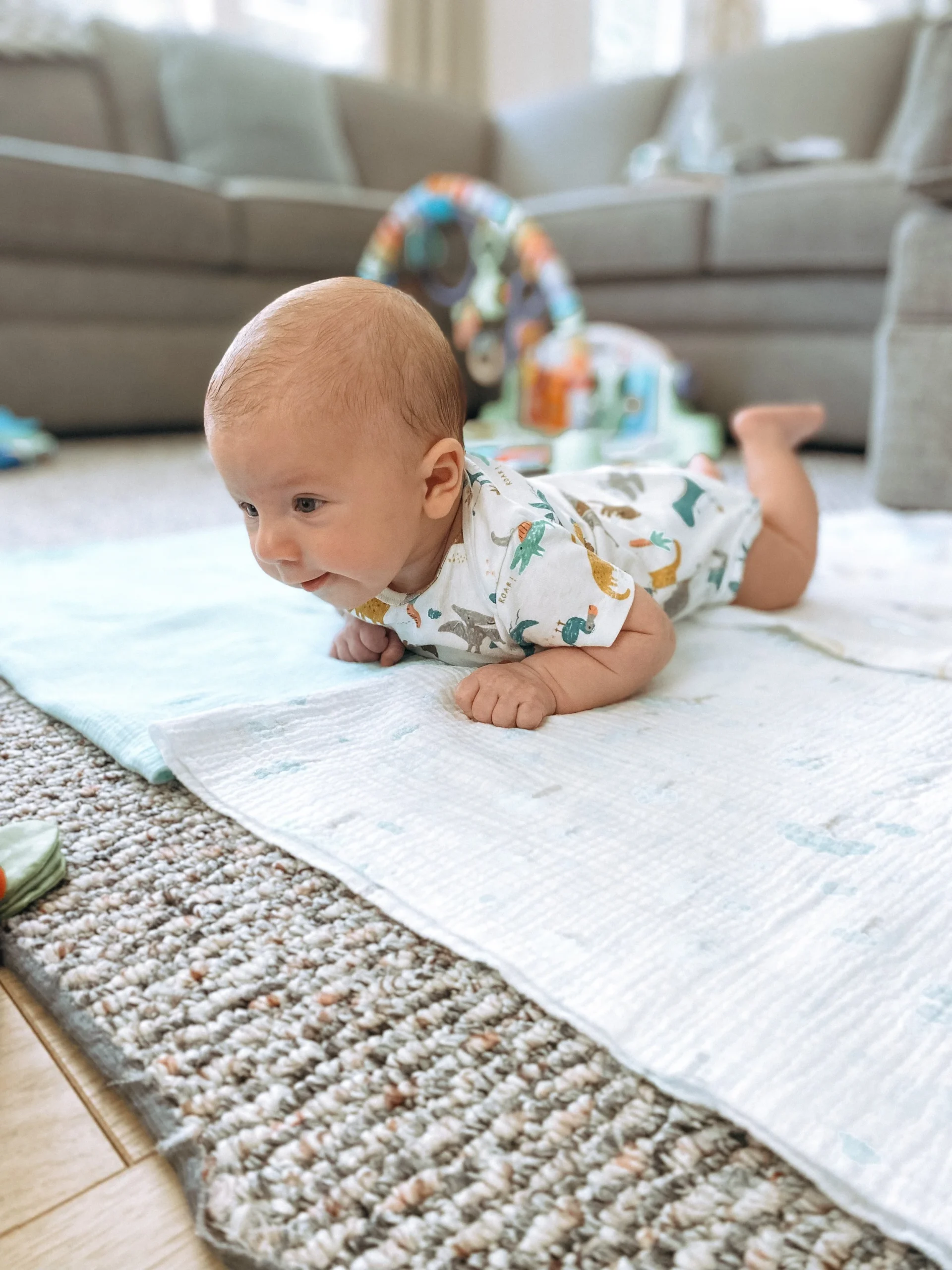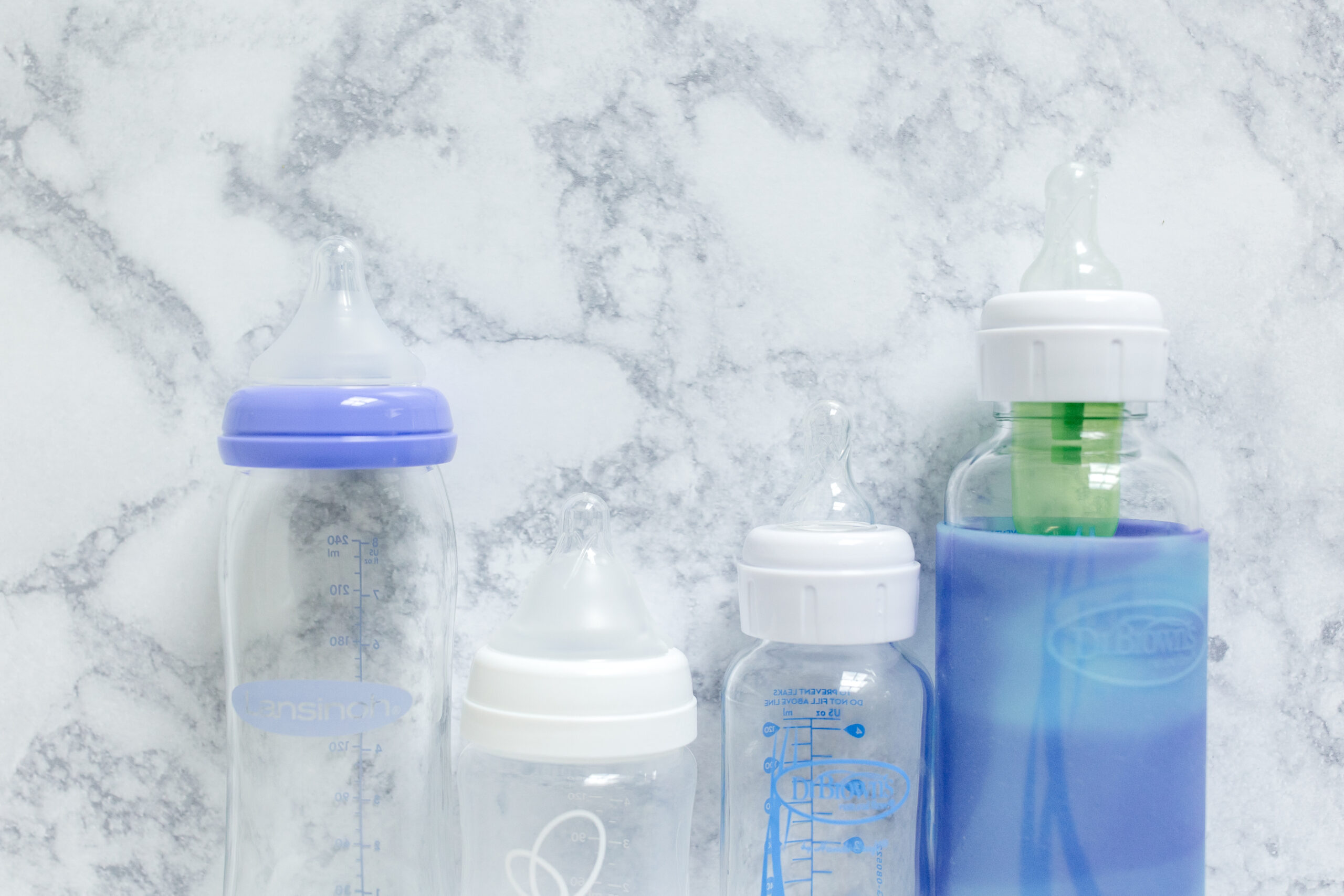This page contains affiliate links. We will receive a commission on qualifying purchases using these links.
If you feel like you have tried all of the tummy time tips and tricks (if you missed the blog with all of those, it’s here!) and your baby is still struggling with tummy time, here are some important things to keep in mind:
Tummy Time & Reflux
Tummy time can be especially daunting when your baby has reflux- the fear of them spitting up what feels like their entire feed, as well as the pain of washing several outfits a day and cleaning up the floor, couch, bed, crib- it’s a lot.
The good news is that tummy time doesn’t have to be flat on the floor!
Here are some tips and tricks to try to help reduce stomach pressure and spit-up:
-
The 20-30 minute Rule: Remember to wait 20-30 minutes after feeding baby to place them on their stomachs. This will give them time to digest their formula/breastmilk and decrease the volume of spit-up
-
Softer Surfaces: Try placing baby on pillows, a Boppy, a couch cushion, or a rolled up blanket in order to relieve pressure to their stomachs. A slightly elevated chest can help prevent or decrease reflux in tummy time.
-
Yoga Ball: These are my favorite for babies experiencing reflux because the yoga ball creates a softer surface for baby’s belly, and you can quickly roll them backwards to a more upright position to work on head control or forward into a flatter position when they need a break.
-
Elevated Tummy Time: Baby wearing can be extremely beneficial for babies who have reflux. Babies can still work on head control in upright positions! Engaging in tummy time practices while baby is elevated works well with gravity, to help keep everything down in the stomach while baby is still working out all of those head, neck, and core muscles.
-
On your Chest: Similar to babywearing, if you sit slightly reclined on the couch and put baby chest-to-chest with you, they will stay mostly upright (at about 45 degrees). They can still work to bring their head up to look at you, as well as move their head left-and-right.
-
Side-lying Position: While this is not a ‘tummy time replacement’, this position is amazing for baby and often gets forgotten about when working towards a successful tummy time experience. Placing baby on their side to look at a mirror or high contrast toy actually does engage many of the core and neck muscles needed for tummy time. Remember to do side lying on both sides.
Remember “Quality over Quantity”
This is especially true for babies experiencing reflux. Start small and work your way up. If baby is spitting up after 1 minute of tummy time, aim for 30-45 seconds. Small successful increments will help increase their time on their tummies. Every little bit counts!
How to Help with Tummy Time
Is baby over-arching their back?
If you are placing baby on their belly and notice their back is overly arched or their arms are stretched out backwards, this could be a sign that baby is actually using more back muscles to maintain tummy time positioning instead of core muscles. It is amazing how even babies can learn to adapt when necessary!
This ensures that they are using the correct group of muscles (core, arm, shoulder, and neck) to maintain their positioning instead of compensating with their back muscles. I also love to utilize a yoga ball for these babies to provide calming sensory movement (rocking lightly back and forth and side to side) can help them relax into a proper tummy time positioning more easily. If you notice that your baby seems tense in tummy time, it’s a good idea to try a yoga ball or try the tips in Number 3 above!
Is baby immediately rolling out of tummy time?
Now it’s time to get creative! It is very common for new rollers (around 3-5 months) to take their newly found independence to roll out of that forced tummy time positioning. After all, this is new and amazing skill they have just learned and we want them to show it off. Although we could all watch our baby roll all day long, it is still important for baby to get some good tummy time work in once they start rolling!
Here are some extra creative things to try to capture that roller’s attention:
-
Sensory Play– We have talked a lot about what baby can LOOK AT on their tummies, but once they start reaching those hands and arms forward around 3-4 months it opens up a whole other sensory system: “tactile.” Not only are we thinking about high contrast and colorful things to look at, but now it’s time to present baby with things that they will want to TOUCH. Some of my favorites are crinkle toys and books and a water mat.
-
Mirrors– Mirror are a fabulous way to help captivate babies’ attention in tummy time. I recommend laying right next to baby and you can both look at each other in the mirror.
-
Household Objects– Okay. Toys are great, but have you noticed that your baby is extra curious about random things around your house? The remote, your cup, your glasses? If you feel like toys are not captivating baby’s attention, go for a random item around the house and see if that helps to spark their interest.
-
Go back to the Yoga Ball– Have I said this one already? (; Tried and true! The yoga ball is a great way to provide your new roller the sensory input they are looking for and receiving from rolling, while keeping them maintained and locked into so good tummy time practices
-
Airplane– Another great way to help give baby the sensory input they are looking for. Lay flat on your back with knees bent and hold baby securely on your knees. You can lightly bounce them up and down and sing them a song to captivate their interest
Is baby hard to get into tummy time positioning?
Maybe you have tried to place your baby on their belly and you notice some awkwardness in their positioning. For example, maybe they keep their head turned to either the left or right side no matter what you try to put in front of them (this is called a head turning preference- we have a blog on that here!). Maybe they are keeping their knees tucked under their belly and are having a hard time laying flat. Maybe they cannot position both elbows under their shoulders to support lifting their head up.
All of these could be signs that there is some underlying tension or a retained primitive reflex present that is making it extra hard for baby to be successful in tummy time (e.g., torticollis, body tension, etc.). The good news is that if these difficulties are identified and addressed early, they can usually be resolved, and resolved swiftly! If any of these are describing your little one, don’t worry! Talk to your pediatrician about an Early Intervention evaluation, and you can book a 1:1 virtual consultation with someone on our team. Baby might just need a little help from an Occupational or Physical Therapist to relieve the extra tension or integrate their reflex.
Tummy time is hard! You’re doing great- and don’t be afraid to ask for help if you or your little one needs it!
This resource helps make Tummy Time enjoyable!






